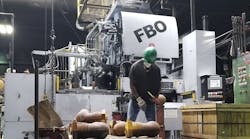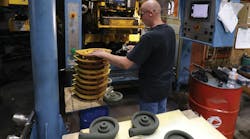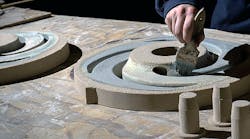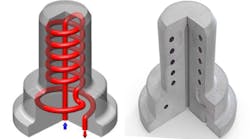One plastic injection-molding specialist has invested in its first additive manufacturing system to produce metal parts for its mold tooling. Spritzguss + Formenbau Bergmann purchased the EOSINT M 280 system and is set to introduce direct metal laser sintering to its current operations, producing complex tool inserts (e.g., cores, slides) and prototype parts directly from the CAD designs.
The DMLS system designer is EOS, which offers a modular portfolio of technologies based on 3D printing technologies, including the manufacturing systems, software, materials and materials research, as well as system maintenance, training, and consulting.
While the purchase of the EOSINT M 280 represents new technology for Bergmann, it’s also scheduled to begin providing manufacturing services to EOS. “We are pleased to have found a strong and highly professional partner for injection molding, one who has many years of experience with conventional technologies but who is at the same time also open to innovative technologies,” according to Augustin Niavas, business development manager for tooling at EOS.
The EOSINT M 280 is described as “ideal for use in … batch-adjusted component production,” for parts like tooling inserts. In addition to the design specificity made possible by the direct importation of CAD data, process control capabilities support “maximum reproducible quality of all components,” according to the developer.
The material most commonly employed in DMLS production of tooling parts is EOS MaragingSteel MS1.
“Using the toolmaking technology,” EOS stated, “it is possible to achieve extremely complex geometries, which can include freeform surfaces, fins and cooling channels. In particular, it is possible to create conformal cooling channels using DMLS, which results in reduced cycle times and quality optimization in the components produced.”
It also noted the system is flexible and integrates easily to existing manufacturing programs.
“Right from the start we were convinced about the benefits of the EOS additive manufacturing process,” stated André Gerbert, assistant to the senior management at Spritzguss + Formenbau Bergmann. “Not only can we employ the new metal system for toolmaking on the premises but we can now also perform contract work for our customers, based on this new manufacturing technique. This means that we are already able to achieve considerable reductions of up to 20% in cycle times.”
“The fact that Bergmann has chosen the EOS technology reflects the level of maturity that additive manufacturing has now attained,” according to Niavas. “Together, we are now able to cover the entire process chain, from the engineering design stage of the tool to the finished plastic component.”









